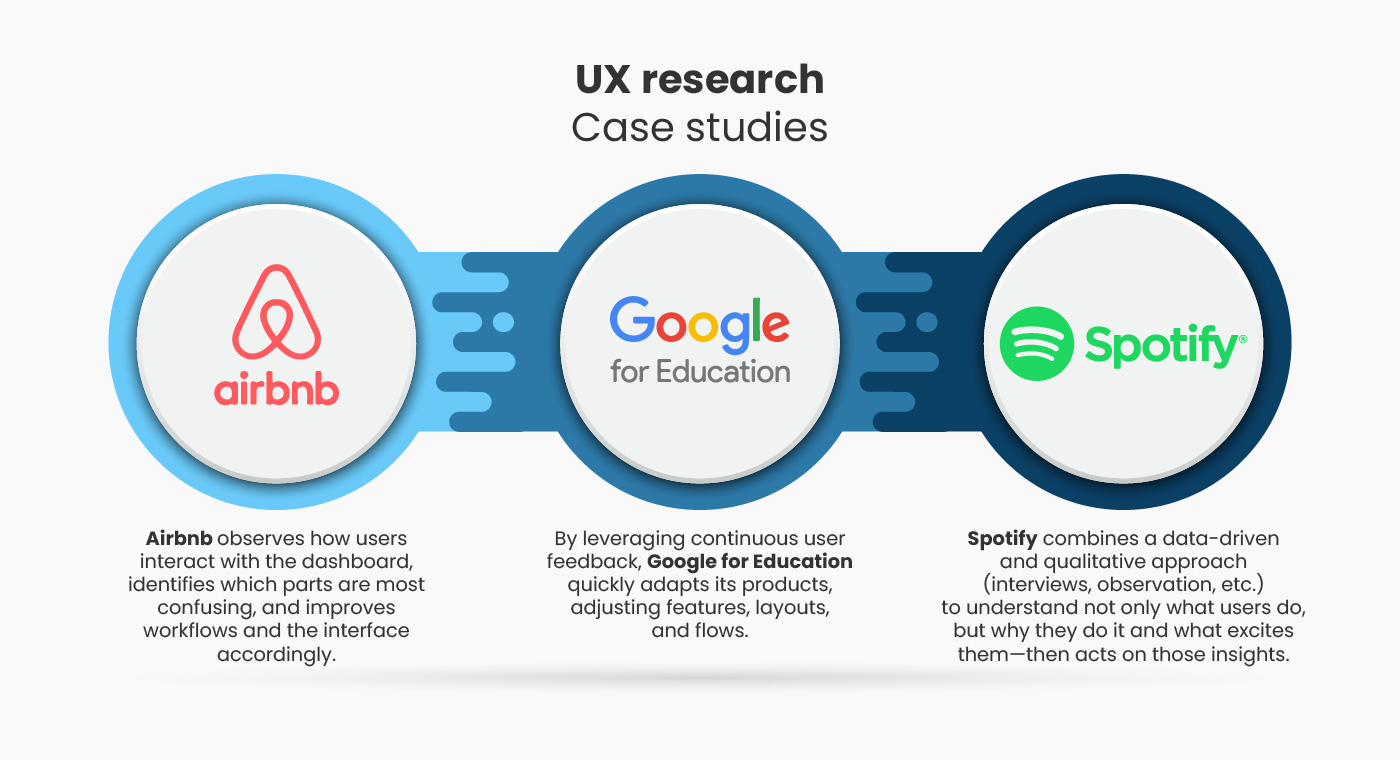UX research is the process of studying users—their needs, behaviors, challenges, and motivations—in order to design digital products (websites, web apps, mobile apps) that are useful, usable, and satisfying.
In practice, this involves collecting both qualitative data (such as interviews, A/B testing, case studies) and quantitative data (analytics, surveys, performance metrics, and more) to guide design and development decisions.
UX research is not an isolated step in the development process—it runs through the entire product lifecycle. Its role is to minimize risks, prevent costly mistakes, and improve product adoption, conversion rates, and overall customer satisfaction.
Table of contents
What does a UX researcher do?
A UX researcher has a wide range of responsibilities. Here are the key ones:
- designing and conducting user studies: interviews, field observations, and focus groups;
- defining personas, i.e., representative profiles of the target users;
- analyzing the customer journey to identify pain points and opportunities;
- collecting and examining quantitative data: metrics, heatmaps, or drop-off rates;
- synthesizing findings into actionable insights that can guide designers, product managers, and developers;
- validating prototypes and mockups before launch;
- monitoring post-launch feedback and continuously improving the product based on real user behavior.
What does UX mean?
UX, short for user experience, refers to the overall experience a person has while using a product (in this case, a digital one). It encompasses every aspect: ease of use (usability), efficiency, satisfaction, accessibility, emotion, aesthetics, and performance.
UX is not just the user interface (UI). It’s about how well the product meets user needs, how it makes them feel, how easy it is to interact with, and how quickly users can achieve their goals.
How much does a UX designer earn?
The salary of a UX designer depends on several factors, including experience, location, type of company (startup, agency, large enterprise), industry (tech, healthcare, fintech, etc.), remote vs. on-site work, and level of responsibility (e.g., whether the role also involves team leadership or strategic duties).
Here are some updated figures for Italy:
- according to Payscale, the average is around €28,930 per year;
- Glassdoor estimates that the average salary for a UX designer in Italy is about €32,000 annually, with entry-level roles starting around €28,200 and more senior positions reaching up to €48,000;
- Indeed reports an average salary of €34,058 per year in Italy;
- more specialized sources indicate that senior or strategic roles can easily exceed €50,000–€60,000 annually.
In short, it varies considerably. For mid-level professionals in Italy, salaries typically range between €30,000 and €45,000. For senior or strategic positions, compensation can go well beyond that.

Case study di UX research
An article from the UX Design Institute highlights three real-world case studies: Airbnb, Google for Education, and Spotify.
1. Airbnb
Airbnb relies on observing user behavior to uncover design opportunities, going beyond interviews and surveys. For example, when hosts manage their listings, the company carefully monitors how they actually use the dashboard—identifying which sections are confusing—and then improves workflows and the interface accordingly.
2. Google for Education
Continuous feedback and research with real users—teachers and students—allow Google for Education to quickly adapt its product. This ongoing process helps refine features, layouts, and user flows in response to real needs.
3. Spotify
Spotify takes a mixed approach, combining data-driven insights (metrics, usage data, etc.) with qualitative research (interviews, observation). This way, they don’t just learn what users do, but also why they do it, what excites them, and how to turn those insights into action.
UX research & web apps
Let’s imagine a startup developing a web app for order management in small restaurants. During development, several issues arise: staff struggle with the “current orders” section, the order confirmation flow is slow, and some features seem unnecessary. A UX researcher can:
- run usability tests, perhaps with prototypes of the web app, simulating real-life scenarios such as taking an order, confirming it, making changes, and closing the order;
- use quantitative metrics: how long does it take a user to complete an order? How many errors occur? How many unnecessary clicks are made?
- interview restaurant staff to gather feedback on difficulties and suggestions for improvement;
- collaborate with the design/development team to restructure the “current orders” section, simplify workflows, remove or hide secondary features, and improve visibility of order statuses (e.g., confirmed, in preparation, ready, etc.).
Another concrete example: a hotel booking web app can use heatmaps to identify where users abandon the booking page, A/B testing to compare two versions of the booking form (one with a mandatory “phone number” field and one optional), and interviews to understand what users are looking for in the reviews or photo sections.
UX research applied to web app development
When developing web apps, UX research plays a particularly important role in the following areas:
- rapid prototyping: building early wireframes or mockups and testing them with real users before investing too much time in front-end development;
- responsiveness and performance: web apps need to work smoothly across different browsers, devices, and even slow connections. UX research helps identify which devices or conditions users rely on, what slows them down, and what causes frustration;
- information architecture: defining how sections, menus, and navigation paths are organized to reach different features;
- onboarding and critical flows: for example, registration, login, password recovery, or the integration of complex functions. If these flows are not seamless, users are likely to drop off;
- post-launch iteration: monitoring analytics, collecting user feedback, and conducting usability tests even after release, to continuously improve and fine-tune the web app.
Tangible benefits of UX research
- cost reduction: preventing design errors that would otherwise require costly rework;
- higher user satisfaction and loyalty: satisfied users are more likely to return and stay engaged;
- increased conversion rates: fewer drop-offs, more leads, and ultimately more sales;
- greater innovation: research often uncovers hidden or latent needs that would never emerge from simple brainstorming sessions.
UX research is not optional. Contact us for collaboration
If you’re developing a web app, a digital product, or rethinking an existing one, UX research is not optional—it’s what makes the difference between a product that merely “works” and one that users truly love.
At HT Apps, we’re ready to collaborate with European companies that want to get it right: from studying how users perceive design, to hands-on development with continuous iteration of web apps.
If you’re looking for a reliable partner to elevate your UX research and enhance the user experience, get in touch with us. Get in touch with us today. Let’s discuss how we can put your users at the center of your next digital project and turn insights into real growth.


